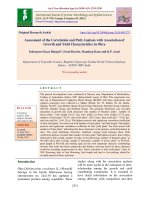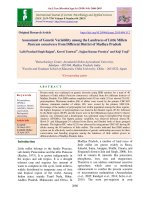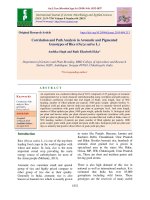Assessment of genetic variability, character association and path analysis in F2 segregating population for quantitative traits in chickpea
Bạn đang xem bản rút gọn của tài liệu. Xem và tải ngay bản đầy đủ của tài liệu tại đây (156.13 KB, 5 trang )
Int.J.Curr.Microbiol.App.Sci (2020) 9(8): 2485-2489
International Journal of Current Microbiology and Applied Sciences
ISSN: 2319-7706 Volume 9 Number 8 (2020)
Journal homepage:
Original Research Article
/>
Assessment of Genetic Variability, Character Association and Path Analysis
in F2 Segregating Population for Quantitative Traits in Chickpea
V. L. Rathod*, V. N. Toprope and L. P. Godade
Department of Genetics and Plant Breeding, College of Agriculture,
Latur-413 512 (M.S.), India
*Corresponding author
ABSTRACT
Keywords
Chickpea,
Variability,
Correlation and
path analysis
Article Info
Accepted:
22 July 2020
Available Online:
10 August 2020
Fifteen F2 segregating populations were grown to assess genetic variability,
character association and path analysis during rabi, 2018-19. The maximum
genotypic coefficient of variation estimates were noticed for test weight,
number of pod yield per plant, seed yield per plant and number of
secondary branches per plant. Moderate to high heritability coupled with
high genetic advance as per cent of mean has been noticed for test weight,
days to maturity, number of pod per plant and seed yield per plant
indicating to the preponderance of additive gene action these characters.
Seed yield showed highly positive significant association with pod per
plant and pods per plant and test weight also exerted highest positive direct
effect on seed yield Thus the Information of the genetic variability,
heritability genetic advance per cent mean correlation and path analysis of
various characters provides a basis to the plant breeders to breed the
chickpea genotypes possessing higher yield potential.
Introduction
Chickpea (Cicer arietinum L.) is the most
important pulse crop and mostly grown under
rainfed conditions in India. India is the largest
producer of chickpea contributing about 40
percent of the total pulse production
occupying an area of 10.56 million hectares
with a production of 11.23 million tones and
with productivity of 1063 kg/ ha. Chickpea is
a good source of protein (18-22%),
carbohydrate (52-70%), fat (4-10%), minerals
(calcium, phosphorus, iron) and vitamins.
Genetic variability is the basic requirement
for making progress in crop breeding. It is
essential to understand the genetic architect
and nature of gene action governing yield and
its component traits. Yield is the resultant
product of various morphological and
biological components. Studies on the
phenotypic and genotypic correlation of the
yield components and their contribution to
2485
Int.J.Curr.Microbiol.App.Sci (2020) 9(8): 2485-2489
yield through path analysis provide
information to design appropriate breeding
strategy towards improvement of the crop
Materials and Methods
The present investigation was carried out in
the experimental farm of College of
Agriculture,
Latur,
Maharashtra.
The
materials comprised of 15 F2 families, the
experiment was laid out in Randomized Block
Design with two replications. Row to row and
plant to plant distance was 30 and 10 cm
respectively and per plot number of rows
were 5. Row length was 4 meters. The crop
was raised with all recommended agronomic
package of practices to maintain a good crop.
Observations were recorded on sixty
competitive and randomly selected plants in
each replication for all the genotypes viz.,
number of primary branches per plant,
number of secondary branches per plant,
number of pods per plant, test weight (g) and
seed yield per plant (g). Observations for days
to 50% flowering and days to maturity were
recorded on plot basis. The mean values were
used for estimation of genotypic and
phenotypic
coefficients
of
variation,
heritability in broad sense and genetic
advance as percent of mean according to
Johnson et al., (1955). Correlation and path
analysis were made according to Dewey and
Lu (1959).
Results and Discussion
The analysis of variance revealed significant
difference for all the traits studied. The
genotypic coefficient of variation, phenotypic
coefficient of variation, heritability and
genetic advance as percent of mean for the
seven characters are given in Table 1. The
analysis revealed that for all the characters
phenotypic coefficient of variation (PCV) was
slightly higher than the genotypic coefficient
of variation (GCV), so it is evident that in
expression of the characters mainly governed
by the genotypes itself along with meagre
effect of environment. Similar observations
were made by Shivkumar et al., (2013) and
Pithiya and Javia (2019). The phenotypic
coefficient of variation and genotypic
coefficient of variation estimates were
relatively high for test weight, number of pod
yield per plant, seed yield per plant and
number of secondary branches per plant in the
decreasing order of their magnitude. These
findings were in accordance with the reports
of Reddy et al., (2017) and Talekar et al.,
(2017) for pods per plant, branches per plant,
seed yield per plant and 100 seed weight;
Raval et al., (2018) for number of branches
per plant, number of pods per plant and seed
yield per plant; Santosh et al., (2018) or pods
per Plant, seed yield per plant, number of
branches and test weight; Pithiya and Javia
(2019) for seed yield per plant, number of
pods per plant and 100-seed weight and
Vekariya (2006) for number of pods per plant
and seed yield per plant in F2 segregating
populations of chickpea.
In the present study moderate to high
heritability coupled with high genetic advance
as per cent of mean has been noticed for test
weight, days to maturity, number of pod per
plant and seed yield per plant indicating to the
preponderance of additive gene action and
selection pressure could profitably be applied
on these characters for yield improvement.
These result are in accordance with earlier
reports of Shivkumar et al., (2013) for
number of pods per plant, number of seeds
per plant , test weight and seed yield per
plant; Telekar et al., (2017) and Pithiya and
Javia (2019) for number of pods per plant,
seed yield per plant and 100-seed weight;
Vekariya (2006) and Raval et al., (2018) for
number of pods per plant and seed yield per
plant and Paneliya et al., (2017) for 100-seed
weight and seed yield per plant in F2
segregating populations.
2486
Int.J.Curr.Microbiol.App.Sci (2020) 9(8): 2485-2489
In this study the genotypic correlation
coefficient were higher than the phenotypic
correlation coefficient of F2 population of
chickpea,
suggesting
strong
inherent
association among the characters studied
(Table 2). Seed yield exhibited highly positive
significant association with pod per plant at
phenotypic and genotypic level. Hence
selection for these characters would possible
be helpful in improving the yield potential of
this crop. Similar kind of association of seed
yield with pods per plant in segregating
generation of chickpea earlier reported by
Vekariya (2006), Gaikwad and Monpara
(2011), Shivakumar et al., (2015), Telekar et
al., (2017) and Santosh et al., (20018).
The inter relationship was positive and
significant among the yield contributing traits
like, number of secondary branches per plant
with pods per plant, whereas, it were negative
and significant among the traits like number
of secondary branches per plant with test
weight and pods per plant with test weight.
Similar kind of interrelations was reported by
Guler et al., (2001) for number of pods per
plant and 100 seed weight and Bhanu et. al.,
(2017) for number of secondary branches per
plant with pods per plant and 100 seed
weight.
The path analysis gives a more realistic
relationship of characters and helps to identify
the effective components of seed yield in
chickpea. A perusal of path coefficient (Table
3) among the characters of F2 population of
chickpea showed that pods per plant and test
weight exerted highest positive direct effect
on seed yield and also had positive
correlation, suggesting, that the prime
importance to selection of these characters for
improving seed yield in chickpea. This is in
agreement with findings of Vekariya (2006),
Shivakumar et al., (2015) and Telekar et al.,
(2017) for pods per plant and test weight.
Table.1 Parameters of genetic variability for yield and yield contributing characters F2
population of chickpea
Sr.
No.
Parameters
Mean GCV
(%)
PCV
(%)
Heritability
(B.S.)%
1
Days to 50%
flowering
Days to maturity
No of primary
branches per plant
Number of secondary
branches per plant
Number of pods per
plant
Test weight per
plant(g)
Seed yield per
plant(g)
45.10
3.56
4.24
70.55
Genetic
Advances
as % of mean
2.78
94.15
2.60
2.97
9.85
3.01
10.88
97.75
81.98
5.70
0.47
6.98
17.53
19.67
79.37
2.24
41.69
28.30
30.07
88.57
22.87
31.27
29.86
30.06
98.68
19.11
12.66
24.85
26.61
87.18
6.05
2
3
4
5
6
7
2487
Int.J.Curr.Microbiol.App.Sci (2020) 9(8): 2485-2489
Table.2 Estimates of genotypic and phenotypic correlations for yield and yield contributing traits
in F2 population of chickpea
Sr. Name of character
No.
1
2
3
4
5
Number of Number of
primary
secondary
branches branches per
per plant
plant
G
Number of
primary branches
P
per plant
G
Number of
secondary
P
branches per plant
G
Number of pods
per plant
P
G
Test weight(g)
Number
of pods
per
plant
Test
weight(g)
Seed
yield per
plant(g)
1.0000
0.0204
0.0840
-0.0379
0.1039
1.0000
0.0063
0.0767
-0.0488
0.0930
1.0000
0.4772*
-0.6229**
0.0643
1.0000
0.4445*
-0.5775**
0.0496
1.0000
-0.5755**
0.6438**
1.0000
-0.5524**
1.0000
0.6393**
0.2139
1.0000
0.2125
1.0000
P
G
Seed yield per
plant(g)
P
1.0000
Table.3 Direct and Indirect effects of yield component on seed yield in F2
population of chickpea
Sr.
No.
Name of
character
1
Number of
primary
branches per
plant
Number of
secondary
branches per
plant
Number of
pods per plant
Test weight(g)
2
3
4
Number
of
primary
branches
per plant
G
0.0348
P
0.0453
Number of
secondary
branches per
plant
Number
of pods
per
plant
Test
weight
(g)
Correlation
with seed
yield per
plant
0.0007
0.0003
0.0029
0.0035
-0.0013
-0.0022
0.1039
0.0930
G
P
0.0023
0.0006
0.1104
0.0957
0.0527
0.0425
0.0687
0.0552
0.0643
0.0496
G
P
G
P
0.0977
0.0847
-0.0309
-0.0375
0.5549
0.4903
-0.5081
-0.4440
1.1630
1.1030
-0.4695
-0.4247
-0.6693
-0.6094
0.8158
0.7688
0.6438**
0.6393**
0.2139
0.2125
Residual effects= 0.2570, 0.3500
2488
Int.J.Curr.Microbiol.App.Sci (2020) 9(8): 2485-2489
From the results from the present
investigation, it can be concluded that the
characters like number of pods per plant, seed
yield per plant and 100-seed weight exhibited
high genotypic coefficient of variation
(GCV), phenotypic coefficient of variation
(PCV), heritability (broad-sense) and genetic
advance expressed as percent of mean.
Number of pods per plant had highly positive
significant association with seed yield per
plant and also exerted highest positive direct
effect on seed yield. Hence, direct selection
for these traits would therefore be most
effective and should be taken into
consideration for the improvement of seed
yield in segregating generations of chickpea.
References
Bhanu, A.N., Singh, M.N., Tharu, R. and
Saroj, S.K. 2017. genetic variability,
correlation and path coefficient analysis
for quantitative traits in chickpea
genotypes. Indian J. Agric. Res., 51(5):
425-430.
Dewey, D.R. and Lu, K.H. 1959. A
correlation and path coefficient analysis
of components of crested wheat grass
seed production. Agronomy Journal 51:
515-518.
Guler, M, Adak, M. S. and Ulukah, H. 2001.
Determining relationship among yield
and some yield components using path
coefficient analysis in Chickpea.
European J. Agron., 14(2): 161-166.
Johnson, R.E., Robinson, H.W., Comstock,
H.F. 1955. Estimates of genetic and
environmental variability in soybean.
Agronomy Journal; 47:314-318.
Paneliya M.R., Mehta D.R., Raval L.J and
Chetariya C.P. 2017. Spectrum of
genetic variation in selection schemes
of desi chickpea (Cicer arietinum L.).
Electronic Journal of Plant Breeding
8(4):1310-1314.
Raval, L, Pithia M.S., Mehta, D. R., Mungra,
K. S. and Shah S. 2018. Spectrum of
variation and transgressive segregation
in F2 generation of desi chickpea. Elect.
J. of Pl. Breed., 9 (1): 18 – 24.
Shivakumar, M. S., Salimath, P. M., Suma,
S., Biradar and Gangashetty, P. I. 2015.
Association Between Yield and Its
Component Traits Under Irrigated And
Drought Conditions In Chickpea.
Annals of Plant and Soil Research 17
(1): 55-59.
Talekar, S. C., Viswanatha, K. P. and
Lohithaswa, H. C. 2017. Assessment of
Genetic
Variability,
Character
Association and Path Analysis in F2
Segregating Population for Quantitative
Traits
in
Chickpea.
Int.J.Curr.Microbiol.App.Sci
(2017)
6(12): 2184-2192.
Vekariya, D. H., Pithia, M. S. and Kalawadia,
R. L. 2008. Correlation and path
analysis in F2 generation of chickpea
(Cicer arietinum L.) Res. On Crops
9(2):371-374.
How to cite this article:
Rathod, V. L., V. N. Toprope and Godade, L. P. 2020. Assessment of Genetic Variability,
Character Association and Path Analysis in F2 Segregating Population for Quantitative Traits in
Chickpea. Int.J.Curr.Microbiol.App.Sci. 9(08): 2485-2489.
doi: />
2489









